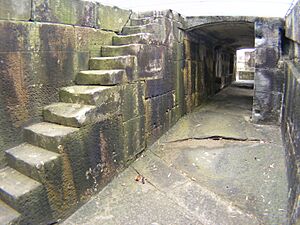Georges Head Battery facts for kids
The Georges Head Fort is an old military fort located at Georges Head, in the suburb of Mosman in Sydney, New South Wales, Australia. This fort was one of many built around Sydney Harbour. Their main job was to protect the colony of New South Wales in case another country tried to invade Australia. By the 1890s, the Georges Head Fort became the most important fort, helping to organize all of Sydney's harbour defences.
Contents
History of the Fort
The land where the fort stands was originally home to Aboriginal people for thousands of years. They lived there long before Europeans arrived and settled.
The Georges Head Fort was built in 1871. This happened after the British Army decided to leave Australia in 1870. When they left, the responsibility for protecting Sydney and its harbour fell to the local colonies, like New South Wales and Victoria. They now had to create their own defence plans.
Georges Head was chosen because it was very close to the entrance of Sydney Harbour. The fort's goal was to stop enemy ships before they could enter the harbour. It was in a great spot, high above the sea, with clear views of the harbour entrance. Other forts were also built at Middle Head, South Head, Shark Point, and Bradleys Head. However, none of these forts were ever used in a real battle against enemy ships or soldiers.
Cannons and Their Placement
The Georges Head Fort was armed with four large 80-pounder cannons and two 68-pounder cannons. These were "muzzle-loading" cannons. This meant that the cannonballs or bullets, along with the explosive charge, had to be loaded into the front of the cannon's barrel.
It took three months and 250 soldiers to move the heavy cannon barrels. They rolled them all the way from North Sydney to the fort. They used a dirt road that later became known as Military Road. Once the cannons were in place, they were positioned very close together. This created a risk that one cannon might accidentally fire at another. Also, the cannons and the soldiers could be easily seen from ships in the harbour.
In 1877, large mounds of earth were built between the gun pits. This was done to prevent the cannons from firing at each other. It also helped to protect the gun crews from enemy fire. When the fort was finally finished, there were a total of 41 gun positions around Sydney Harbour.
Communication and Defence Planning
The defence plans were made using telescopes and plotting tools. These were located in the middle of the second gun pit. From a special telephone exchange, the main commander of the Port Jackson area could talk to all the other forts around the harbour. Telephone wires ran through tunnels, down the cliff, and even under the harbour to reach forts on the other side.
Georges Head was later chosen as the best place to watch for ships and to control underwater mines. In 1888, the Georges Head battery was updated with the newest harbour defence technology: submarine bombs. These minefields were placed across the main shipping channels of Port Jackson from 1876 to 1922. A special base for the submarine miners was built at Chowder Bay.
From Georges Head, miners watched for ships entering the harbour. Their job was to explode the mine closest to an approaching enemy ship. Each underwater mine was connected to an electric cable. This cable ran up the cliff to the firing post. The work of these submarine miners was very secret, technical, and dangerous. In 1891, during a demonstration, a sad accident occurred. Four miners died, and eight others were injured.
Gallery
-
RML 10 inch 18 ton gun in 1891
-
Replaced by BL 6 inch Mk V guns in 1892
Images for kids



















